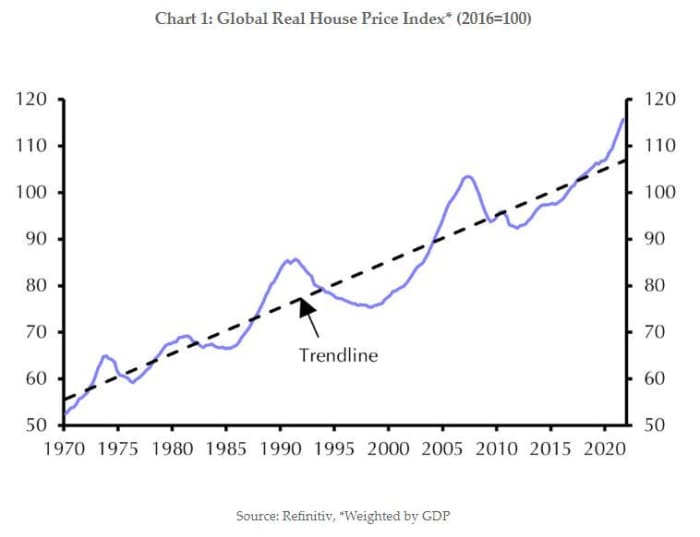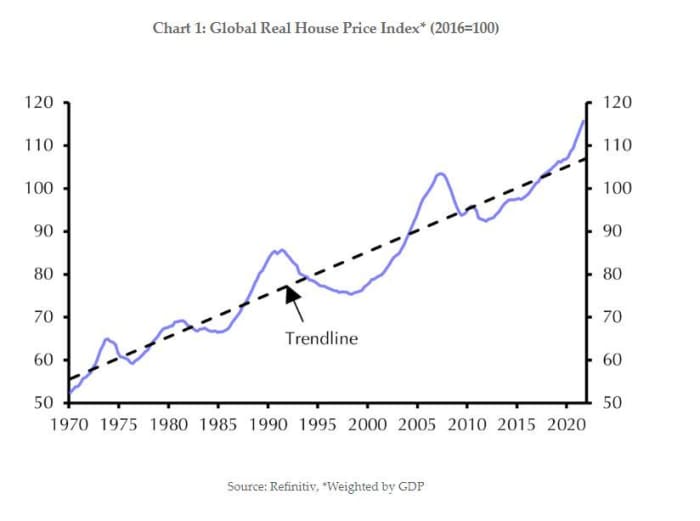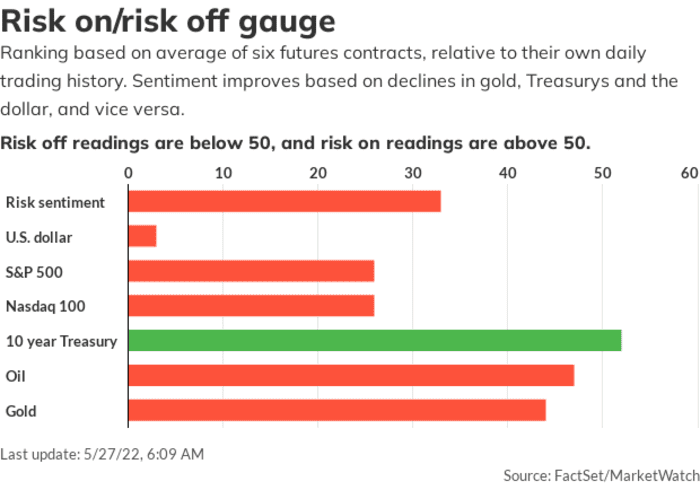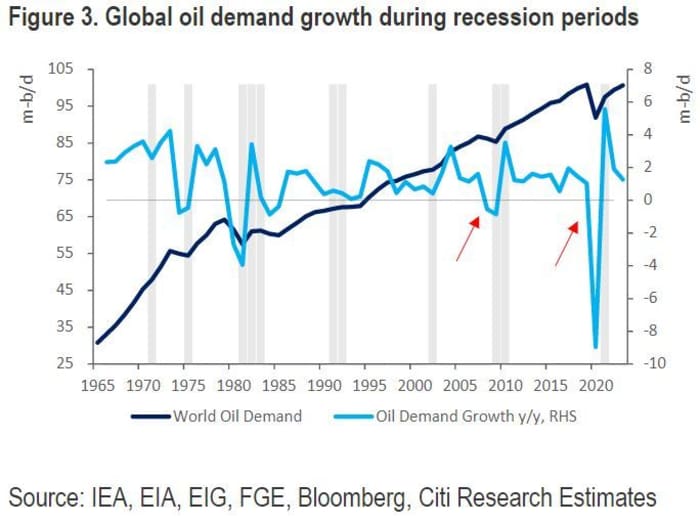This post was originally published on this site
Stocks are set to veer south post holiday, following earlier optimism over reports President Joe Biden may lower tariffs on some Chinese goods to help ease the inflation sting.
There isn’t much to explain the moodiness of stocks, which logged gains on Friday, but weekly losses on worries about a recession spurred on by rising U.S. interest rates.
With the economy in flux and rates rising, a big question is hanging over a sector that has been putting money in the pockets of Americans for years. And our call of the day from Capital Economics’ group chief economist Neil Shearing says don’t expect 2008-like housing-price drops.
That’s even as “in real terms global house prices are now running well above their long-run trend, and the recent surge in prices looks alarmingly similar to what happened in the run-up to the global financial crisis,” said Shearing in a note.

Capitol Economics, Refinitv
In the U.S., mortgage applications are down 28% from their peak, new home sales are off 17% and housing starts down 13%. That’s also being played out across the U.K., Canada, Australia, New Zealand and Sweden, he said.
His next chart shows global housing prices, notably hot in Canada, Australia and New Zealand, but also up in double digits in the U.S. and U.K.

Capital Economics, Refinitiv
A big difference between now and bubbly 2008 is that surging mortgage debt drove the latter. Homeowners stuck with negative equity and forced to sell led to a downward spiral of the sector. But these days the housing market is far less leveraged and regulations put in place after 2008 have left banks in better shape.
“Instead, the latest surge in house prices has been underpinned by the extremely low level of nominal (and real) interest rates,” said Shearing.
Rising rates will probably squeeze first-time buyers and homeowners needing to finance. “And there are growing signs that this rise in borrowing costs — and the anticipation of further increases to come — is already fueling sharp downturns in housing markets across advanced economies,” said Shearing.
Capital Economics has previously outlined the four stages of housing downturns — 1) Weakness of housing market sentiment 2) Measures of buyer traffic fall back 3) Measures of housing market activity start to drop, and 4) House prices themselves fall.
Shearing said the U.S., U.K. Canada, Australia, New Zealand and Sweden are in stage 3 of that process. And compared with the mid-2000s, this one is “happening more quickly, with most indicators showing sharper initial falls,” he said.
“That doesn’t mean we should expect the same scale of price falls in the fourth stage as were seen around the global financial crisis. The macro backdrop and market dynamics are different to the mid-2000s, and the outlook today varies between economies,” said Shearing.
So, what are his predictions? The biggest housing price falls will hit the most overvalued markets — 20% in Canada and New Zealand, followed by 15% in Australia and 10% to 15% in Sweden. But the U.K. will see smaller drops of 5% to 10% and in the U.S., expect about a 5% drop, said Shearing.
But the fact that “indicators in the first three stages of the downturn have rolled over so quickly suggests that we should expect to see prices falls in all of these markets soon,” he said.
The good news is that a crisis on the scale of 2008 is unlikely, with a boom-to-bust housing shift likely to shave 0.5% to 2% off U.S., U.K., Canada, Australia and New Zealand gross domestic product in the next two years. But don’t look to the Federal Reserve or Bank of England especially to back down on rates, Shearing cautioned.
The buzz
Tesla
TSLA,
said it delivered about 255,000 vehicles in the second quarter, versus the previous quarter’s 310,000.
Allen & Company’s annual summer camp for billionaires kicks off Tuesday in Sun Valley Idaho, with Tesla CEO Elon Musk, Amazon’s
AMZN,
CEO Andy Jassy and some Disney
DIS,
bosses on the guest list.
Read: Ray Dalio attacks U.S. populists, warns Russia may be ‘lesser loser’ in Ukraine war
A China services purchasing managers index rebounded in June. In the U.S., factory and core capital equipment orders are coming later in a week that ends with June jobs data. Australia raised interest rates for a third straight month.
Chicago police have a person of interest in custody after a gunman opened fire on a Fourth of July parade in an affluent suburb, killing six and injuring 30.
The markets

U.S. stock futures
ES00,
NQ00,
are down, bond yields
TMUBMUSD10Y,
are up, copper
HG00,
is extending its losing streak, WTI crude
CL.1,
is steady and Brent
BRN00,
is dropping. The dollar
DXY,
is surging on a slumping euro
EURUSD,
The chart
Citigroup analysts say Brent crude could drop to $65 a barrel by year-end, and $45/bbl. by end-2023, “absent intervention by OPEC+ and a decline in short-cycle oil investment,” according to a team led by Francesco Martoccia.
Citi argues that while historical evidence shows oil demand only goes negative in the worst global recessions, prices “fall in all recessions to roughly the marginal cost.”

IEA, EIA, EIG, FGE, Citi Research Estimates
Also read: A recession could take oil to $55, says BCA Research
The tickers
These were the top-searched tickers on MarketWatch as of 6 a.m. Eastern:
| Ticker | Security name |
|
TSLA, |
Tesla |
|
GME, |
GameStop |
|
AMC, |
AMC Entertainment |
|
NIO, |
NIO |
|
ENDP, |
Endo International |
|
AAPL, |
Apple |
|
AMZN, |
Amazon |
|
NVDA, |
Nvidia |
|
EVFM, |
Evofem Biosciences |
|
BABA, |
Alibaba |
Random reads
After an epic appearance on “Stranger Things 4,” Metallica’s heavy metal 1980s hit “Master of Puppets” is topping the charts.
Star Keanu Reeves’ “class act” interaction with a young fan has gone viral.
Need to Know starts early and is updated until the opening bell, but sign up here to get it delivered once to your email box. The emailed version will be sent out at about 7:30 a.m. Eastern.
Want more for the day ahead? Sign up for The Barron’s Daily, a morning briefing for investors, including exclusive commentary from Barron’s and MarketWatch writers.

